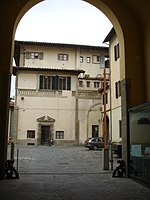Oratory of Gesù Pellegrino
16th-century Roman Catholic church buildings in ItalyRenaissance architecture in FlorenceRoman Catholic churches in Florence

The Oratory of Gesù Pellegrino, also called the Oratorio dei Pretoni, is a Roman Catholic prayer hall or small church found on the corner of Via San Gallo and via degli Arazzieri in Florence, region of Tuscany, Italy.
Excerpt from the Wikipedia article Oratory of Gesù Pellegrino (License: CC BY-SA 3.0, Authors, Images).Oratory of Gesù Pellegrino
Via degli Arazzieri, Florence Quartiere 1
Geographical coordinates (GPS) Address External links Nearby Places Show on map
Geographical coordinates (GPS)
| Latitude | Longitude |
|---|---|
| N 43.778461111111 ° | E 11.257577777778 ° |
Address
Oratorio di Gesù Pellegrino
Via degli Arazzieri
50112 Florence, Quartiere 1
Tuscany, Italy
Open on Google Maps









